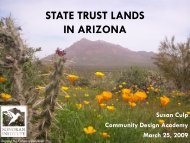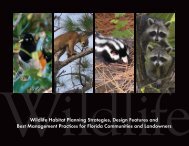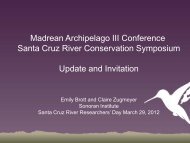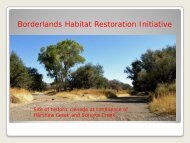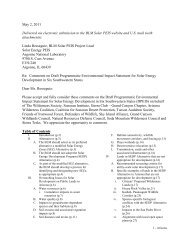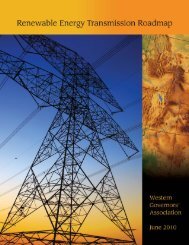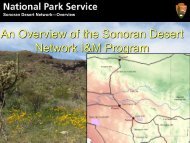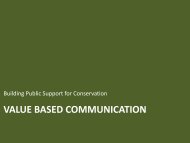Arizona State Trust Lands Conservation Profile: - Sonoran Institute
Arizona State Trust Lands Conservation Profile: - Sonoran Institute
Arizona State Trust Lands Conservation Profile: - Sonoran Institute
You also want an ePaper? Increase the reach of your titles
YUMPU automatically turns print PDFs into web optimized ePapers that Google loves.
<strong>Sonoran</strong> <strong>Institute</strong>,<br />
in collaboration with<br />
conservation groups<br />
across <strong>Arizona</strong> and with<br />
funding from the Nina<br />
Mason Pulliam Charitable<br />
<strong>Trust</strong>, has assembled<br />
state trust lands suitable<br />
for conservation into a<br />
single database. The<br />
resulting profiles focus<br />
on conservation values.<br />
Political values are left<br />
for another day.<br />
Shaping the Future of the West<br />
arizona state<br />
trust lands<br />
<strong>Conservation</strong> <strong>Profile</strong>:<br />
Centennial Forest/Fort Tuthill<br />
Nature as a laboratory<br />
Northern <strong>Arizona</strong> University’s (NAU) Centennial<br />
Forest serves as the University’s research, teaching,<br />
and demonstration forest, a cooperative venture<br />
between NAU and the <strong>Arizona</strong> <strong>State</strong> Land Department<br />
(ASLD). In 1959, the ASLD designated 4,000 acres of<br />
forest land as an “outdoor laboratory” for the School<br />
of Forestry at <strong>Arizona</strong> <strong>State</strong> College in Flagstaff (now<br />
NAU). The research and education programs initiated<br />
by the designation helped establish the school as one<br />
of the top rated forestry institutions in the country.<br />
In 2000, an additional 42,000 acres were included for<br />
management for research and education. While it is<br />
managed by the School of Forestry, it is an asset for<br />
the entire University and northern <strong>Arizona</strong>.<br />
Jim Allen, Executive Director, School of Forestry<br />
at NAU says that Centennial Forest supports a<br />
variety of educational programs for K-12 and NAU<br />
students. The goal is to foster the love of nature in<br />
kids and get them out in the woods to demonstrate<br />
the wonders of the forest. The successful and long<br />
standing environmental summer education camp<br />
in Centennial Forest is part of NAU’s and Flagstaff’s<br />
combined identity.<br />
“Look deep into nature, and then you will<br />
understand everything better. ”<br />
~ Albert Einstein<br />
www.sonoraninstitute.org
locatioN<br />
Centennial Forest/Fort Tuthill<br />
Currently, the NAU Centennial Forest consists of approximately 47,000 acres of forest, woodland,<br />
and rangeland, located a short distance from Flagstaff. The Centennial Forest sits atop the southern<br />
edge of the Colorado Plateau.<br />
Centennial Forest is not a contiguous piece of land but randomly spread parcels throughout<br />
northeastern <strong>Arizona</strong>. The largest parcel is approximately 20,000 acres adjacent to and west of<br />
Wupatki National Monument, which lies north and east of Flagstaff. The other 20,000 acres are<br />
parcels checker boarded southwest of the City.<br />
Map Area<br />
Centennial Forest<br />
Page 2 <strong>Arizona</strong> <strong>State</strong> <strong>Trust</strong> <strong>Lands</strong> <strong>Conservation</strong> <strong>Profile</strong><br />
Centennial Forest & Fort Tuthill Areas<br />
<strong>State</strong> <strong>Trust</strong> Land Parcels for <strong>Conservation</strong><br />
Navajo Army Depot<br />
40<br />
89A<br />
Coconino N.F.<br />
Observatory Mesa<br />
66<br />
FLAGSTAFF<br />
17<br />
<strong>State</strong> <strong>Trust</strong> Land<br />
for <strong>Conservation</strong><br />
National Forest<br />
<strong>State</strong> <strong>Trust</strong> Land<br />
National Parks<br />
& Monuments<br />
Private Land
ReAson FoR ConseRVATIon<br />
Centennial Forest/Fort Tuthill<br />
Several million years ago lava began to flow over<br />
this sedimentary plateau in the vicinity of Williams,<br />
<strong>Arizona</strong>. The zone of active volcanism slowly migrated<br />
northeastward to the area around Sunset Crater which<br />
erupted during the 11th century. One of the newest and<br />
most striking volcanic features on the Centennial Forest<br />
is SP Crater which erupted a little over 70,000 years ago<br />
and is considered a toddler in crater chronology. If you<br />
did not know better, you might think you were on the<br />
moon. Although the cinder cone is only about 800 feet<br />
from base to top, it is steep and scree-covered, making<br />
ascent a bit arduous. The sharp a’a (ah ah) lava flows<br />
associated with this cinder cone have been used by<br />
NASA to test the robustness of space suits.<br />
The historic Fort Tuthill County Park<br />
is nestled in cool Ponderosa pines,<br />
three miles south of Flagstaff. The<br />
413-acre regional park is the home of<br />
the annual Coconino County Fair, held<br />
Labor Day weekend, and the award<br />
winning Amphitheater, used extensively<br />
throughout the summer. Additionally,<br />
the park features a Military Museum,<br />
campground, picnic areas, tennis courts<br />
and scenic trails all within the Centennial<br />
Forest boundaries. In the summer Fort<br />
Tuthill is bustling with a variety of special<br />
events, camping, and picnicking.<br />
All photos courtesey of Northern <strong>Arizona</strong> University<br />
ariZoNa state<br />
trust laND<br />
In 1912, the federal government gave<br />
10.5 million acres of state trust lands<br />
to the new state of <strong>Arizona</strong>. These<br />
lands are not owned by the state,<br />
but are held in trust for the benefit of<br />
the state’s school system and several<br />
other beneficiaries.<br />
Proceeds from the sale or lease of<br />
these lands generated about $50<br />
million for the beneficiaries in 2010.<br />
The <strong>Arizona</strong> <strong>State</strong> Land Department,<br />
in its role as trustee for the<br />
beneficiaries, is constitutionally<br />
obligated to seek maximum financial<br />
return for trust lands.<br />
This requirement has complicated<br />
efforts to preserve state trust land for<br />
recreational use and environmental<br />
protection. The state cannot simply<br />
turn a parcel of trust land into a park<br />
or nature preserve since it is required<br />
to receive full market value for the<br />
land. All state trust land is subject to<br />
sale or lease to the highest bidder.<br />
Preservation of trust land requires<br />
sustained community input coupled<br />
with legislative action.<br />
<strong>Arizona</strong> <strong>State</strong> <strong>Trust</strong> Lans <strong>Conservation</strong> <strong>Profile</strong> Page 3
sTATe TRusT lAnd ConseRVATIon<br />
Collaborating Partners<br />
The Grand Canyon <strong>Trust</strong> has a long history of helping to protect state lands in northern <strong>Arizona</strong><br />
through collaborative planning efforts and open space initiatives.<br />
The Nina Mason Pulliam Charitable <strong>Trust</strong> seeks to help people in need, especially women, children<br />
and families; to protect animals and nature; and to enrich community life in the metropolitan areas<br />
of Indianapolis and Phoenix.<br />
The <strong>Sonoran</strong> <strong>Institute</strong> inspires and enables community decisions and public policies that respect<br />
the land and people of western North America. Facing rapid change, communities in the West value<br />
their natural and cultural resources, which support resilient environmental and economic systems.<br />
Founded in 1990, the <strong>Sonoran</strong> <strong>Institute</strong> helps communities conserve and restore those resources<br />
and manage growth and change through collaboration, civil dialogue, sound information, practical<br />
solutions and big-picture thinking. The <strong>Sonoran</strong> <strong>Institute</strong> is a nonprofit organization with offices<br />
in Tucson and Phoenix, <strong>Arizona</strong>; Bozeman, Montana; Glenwood Springs, Colorado; Sheridan,<br />
Wyoming; Twentynine Palms, California; and Mexicali, Baja California, Mexico.<br />
CONTACT:<br />
Dave Richins, Director<br />
Sun Corridor Legacy Program<br />
11010 N. Tatum Blvd, Ste D101<br />
Phoenix, AZ 85028<br />
(602) 393-4310 x 309<br />
drichins@sonoraninstitute.org<br />
Page 4 <strong>Arizona</strong> <strong>State</strong> <strong>Trust</strong> <strong>Lands</strong> <strong>Conservation</strong> <strong>Profile</strong><br />
www.sonoraninstitute.org<br />
Shaping the Future of the West<br />
10/8/2012




